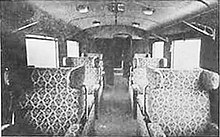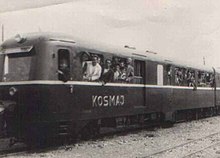JDŽ 488
| JDŽ 488 / JŽ 801 | |
|---|---|
|
Three-part train with JDŽ 801 as the end car in Ustiprača
|
|
| Numbering: | JDŽ 488-000 - 012 JŽ 801-001 - 012 |
| Manufacturer: | Quite , Slawonski Brod |
| Axis formula : | B'B '(+ 2'2' + B'B ') |
| Gauge : | 760 mm ( Bosnian gauge ) |
| Total wheelbase: | 12.5 m |
| Service mass: | 28 t |
| Wheel set mass : | 8 t |
| Installed capacity: | 235 kW (173 hp ) |
| Traction power: | 183 kW (135 hp) |
| Motor type: | Quite VI JaR170 / 240 |
| Motor type: | diesel |
| Power transmission: | mechanically |
| Seats: | 1st class: 46 2nd class: 56 |
The class JDŽ 488 , later JŽ class 801 , were diesel multiple units of the Yugoslav State Railways (JDŽ) in Bosnian gauge , which were delivered in 1938 and 1939 by Ganz in Budapest and the Slawonski Brod machine factory . With two railcars and one intermediate car 448-000-006 (806-001-006), three-part trains were formed, which were used as express trains and a. operated between Belgrade and Sarajevo .
description
After standard-gauge diesel multiple units had proven their worth, the JD® procured seven three-part class 488/448 multiple units with a maximum speed of 60 km / h in the late 1930s to increase cruising speed on their extensive narrow-gauge network. The diesel-mechanical drive for the silver-colored vehicles was supplied by Ganz in Budapest; the car bodies came from the Slawonski Brod machine factory , where final assembly was also carried out. The diesel engine was located together with the clutch and the manual and reversing gear in a spring-loaded subframe. The drive was via cardan shafts on the two bogies , with all four axles being driven. The powerful motorization with two 173 HP diesel engines and magnetic rail brakes allowed the drive over the rack and pinion route of the Ivan Pass in adhesion mode .
The multiple units had 46 1st and 56 2nd class seats and a small buffet in the non-powered intermediate car. Because it was not possible to travel with inexpensive third-class tickets, a large part of the population could not afford to travel with the modern multiple units.
commitment
With the summer timetable on May 15, 1939, the fast travel times for the diesel multiple units came into force. The high speed for narrow-gauge railways earned the trains the name ludi Sarajlija (crazy Sarajevoer). Due to the looming Second World War , however, the wealthy tourists stayed away and on October 15, 1939 the vehicles were withdrawn from the Sarajevo – Gabela –Dubrovnik route . The trains initially ran from Sarajevo to Bosanski Brod and via the East and Sargan Railway to Belgrade. In 1939, the lack of demand led to the complete cessation of operations and the vehicles were drawn in Sarajevo.

After the war, the restart of the three-part diesel multiple units became a showcase project. The railcars 488-002 and 013 and the intermediate car 448-001 had to be retired due to severe damage. The other vehicles were repaired and given a red paint job in keeping with the communism that was now ruling . The six new compositions were named 1. Maj , Sutjeska , Kozara , 29. Novembar , Kosmaj and Istra , with 1. Maj referring to the restart of the first train on May 1, 1946. The red color scheme was soon replaced by the original silver color, and the names were retained for some time. The railcars were given the numbers 806-001 - 006, the intermediate cars were designated 806-001 - 006. After the standard gauge line Sarajevo – Šamac went into operation , the compositions traveled mainly over the Ivan Pass to the Adriatic coast until 1966 . With the shutdown of the Yugoslav narrow-gauge railways in the 1970s, the diesel multiple units lost the rest of their operational area.
swell
- Werner Schiendl , Franz Gemeinböck: The railways in Bosnia and Herzegovina 1918 - 2016. Edition Bahn im Film, Vienna 2017, ISBN 978-3-9503096-7-6 , pp. 130, 160–161 u. 267
- Motorni voz serije 801 (class 801 multiple units) at the Serbian- speaking forum Forum ljubitelja železnica , accessed on April 30, 2018.
Web links
Individual evidence
- ↑ Schiendl, Gemeinböck: The railways in Bosnia and Herzegovina 1918 - 2016 , p. 160




